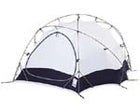In a word, no. While not inherently fragile, you have to expect some tradeoffs with these wispy creations. Ultralight tents typically use thinner fabrics and poles, plus fewer poles, to shave ounces. They’re fine for backpacking or even mountaineering where you can dig them in or find a sheltered place to pitch them.
 Stretch Dome AST
Stretch Dome AST
But for Patagonia, aka the Place Where Tents Go to Die, you could encounter winds close to 100 mph on a regular basis and won’t want to be fooling with a three-pound tent聴and I don’t care who made it. You need something designed for those conditions. And, perhaps regrettably, that takes a tent with some mass to it.
Maybe you’ve been shopping for one already. All the big tentmakers turn out expedition-style tents, and all are pretty good. Sierra Designs’ Stretch Dome AST ($469; www.sierradesigns.com) is typical of what you’ll need聴a roomy, sturdy tent that can be truly and thoroughly guyed out. Marmot’s slightly smaller and lighter Thor ($469; www.marmot.com) is another reliable choice. And, I like Mountain Hardwear’s Trango 2 ($425; www.mountainhardwear.com). All share the same basic design and materials; you’ll want to look at a few and set them up to compare headroom, interior space, construction, and that sort of thing. Expect to pack eight to nine pounds, though. There’s just no way around it. You’ll also need to carry plenty of sturdy cord for guy-outs, a tent-repair kit, and duct tape, lots of it, for when the wind really starts to bare its teeth.
Good luck!


